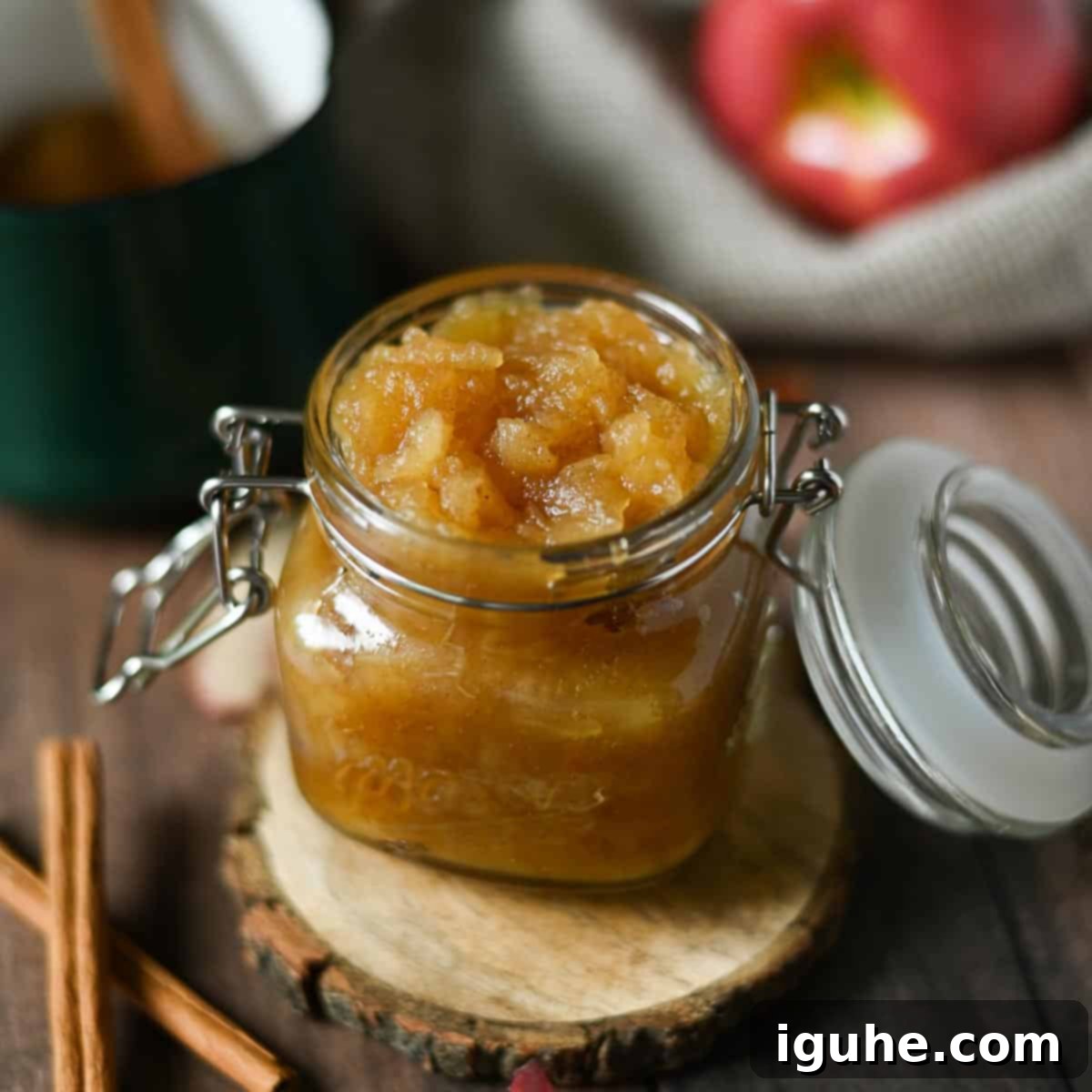Easy Homemade Honeycrisp Applesauce: The Best Recipe with Brown Sugar & Cinnamon
Forget store-bought! There’s something truly special about the rich aroma and comforting taste of homemade applesauce. And while you might associate applesauce with crisp autumn days, this delightful Honeycrisp Applesauce with Brown Sugar and Cinnamon recipe is perfect for enjoying any time of year. Using the beloved Honeycrisp apple – celebrated for its incredible crispness and juicy sweetness – guarantees a batch of applesauce so delicious, it will undoubtedly become your new favorite. It’s surprisingly easy to make, requires just a few simple ingredients, and delivers a flavor that’s reminiscent of the best homemade apple pie.
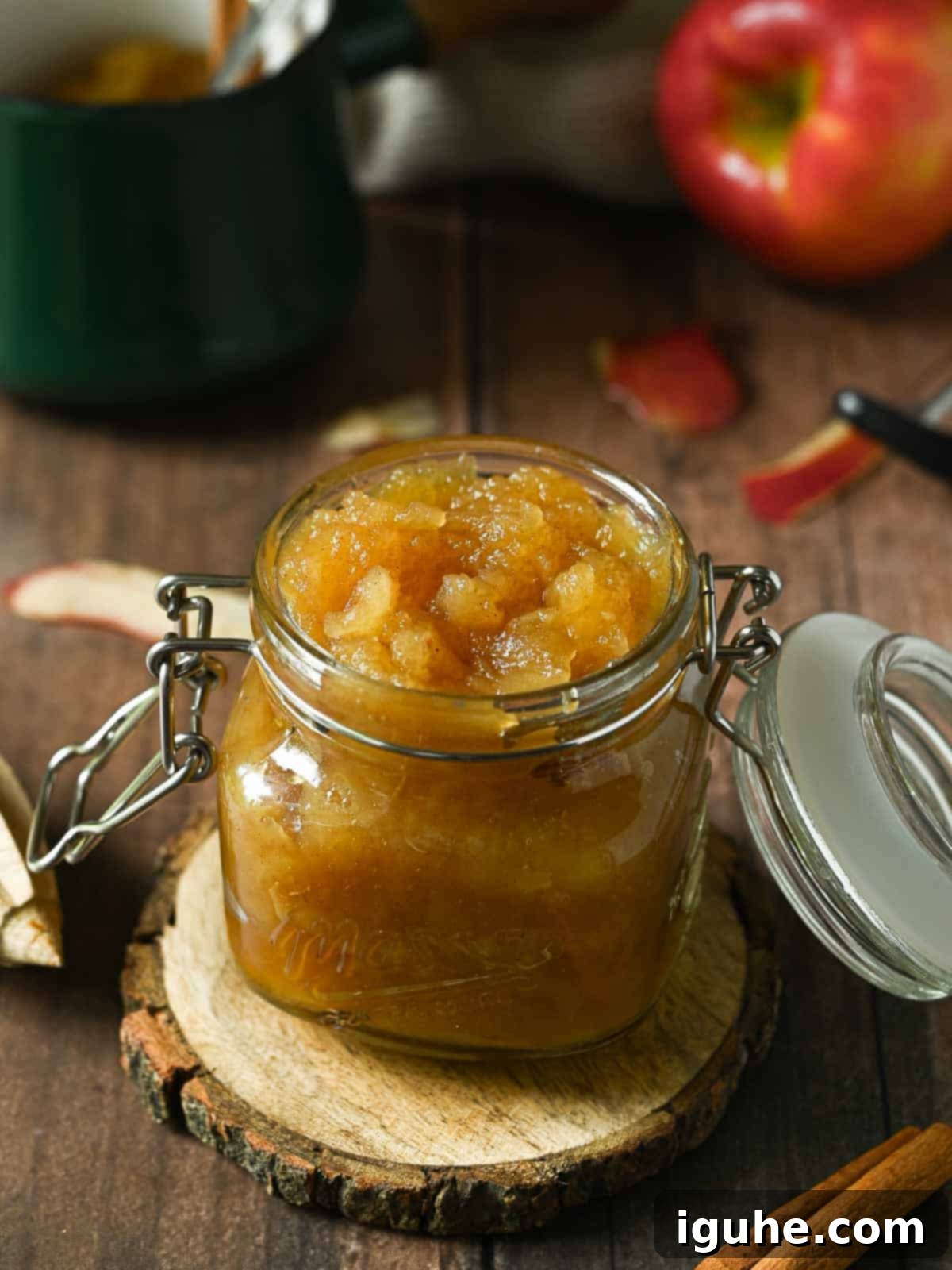
If you’ve ever ventured into making homemade applesauce, you’ll know just how surprisingly simple and rewarding it is. All you really need is a sturdy pot, a handful of fresh apples, and a few pantry staples, and you’re well on your way to a warm, fruit-filled delight. The process is straightforward, yielding a result far superior to anything you’d find in a jar at the grocery store.
While applesauce can technically be made with any apple variety, choosing the right apple can elevate your final product from good to absolutely phenomenal. Honeycrisp apples, as their name suggests, boast a remarkable balance of sweet “honey” notes and an incredibly satisfying “crisp” texture, even when cooked. This makes them a standout choice for creating a naturally sweet and vibrantly flavored applesauce. Their inherent juiciness and flavor profile means less added sugar is often needed, allowing the true apple essence to shine.
This particular Honeycrisp applesauce recipe is crafted to evoke the comforting taste of a homemade apple pie filling, but with a refined touch. The addition of dark brown sugar introduces a deep, molasses-like warmth that complements the apples beautifully, while a touch of cinnamon adds a classic, aromatic spice. The beauty of this recipe also lies in its flexibility: you can easily adjust the sweetness and spice levels to match your personal preference, ensuring every spoonful is exactly to your liking.
[feast_advanced_jump_to]
Why Honeycrisp Apples Are Perfect for Applesauce
Everything about Honeycrisp apples makes them a superior choice for applesauce. Okay, that might sound a little dramatic, but once you try them, you’ll understand! I’ve rarely encountered a Honeycrisp apple that isn’t wonderfully crisp and bursting with juice. And let’s be honest, nothing ruins an apple experience quite like biting into a mealy, dry apple. Honeycrisps consistently deliver on their promise of a premium eating experience, making them ideal for transforming into a luscious applesauce.
Honeycrisp apples are renowned for their signature sweet, juicy, and incredibly crisp texture. This makes them a fantastic apple for eating raw, but these very qualities also translate beautifully into cooked applications. Unlike some varieties that turn to mush instantly, Honeycrisps maintain a pleasant texture even after simmering, allowing you to achieve your desired consistency – whether you prefer a chunkier, rustic applesauce or a silky-smooth puree. Furthermore, they boast a longer shelf-life compared to many other apples and retain their vibrant color well, ensuring your homemade applesauce looks as good as it tastes. So, if you ever find yourself with a bushel of these gems, rest assured they’ll be put to good use!
Beyond their delightful taste and texture, Honeycrisps contribute to a more flavorful and aromatic applesauce. Their natural sweetness means you often need less added sugar, allowing the pure apple flavor to take center stage. When combined with brown sugar and cinnamon, the Honeycrisp’s inherent notes are amplified, creating a complex and deeply satisfying flavor profile that sets this applesauce apart from the rest. It’s truly an apple that keeps on giving!
Essential Ingredients for the Best Honeycrisp Applesauce
You’ll be amazed that such a flavorful applesauce can be made with only five core ingredients (plus an optional secret weapon!). For the complete list of ingredients and detailed instructions, make sure to check out the recipe card further down.
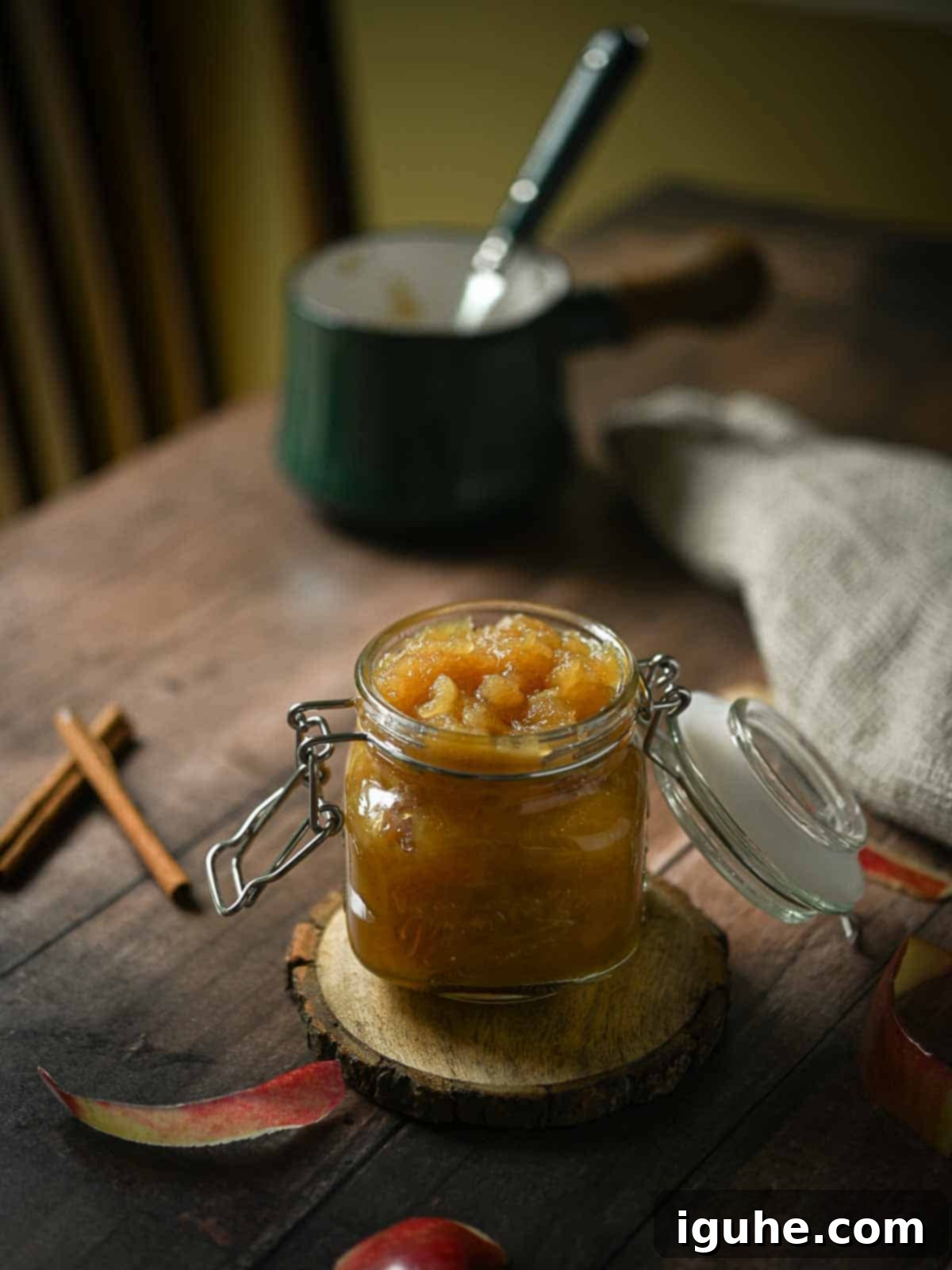
- Honeycrisp apples: These are the undeniable star of our show, delivering that perfect balance of sweetness and tartness, along with a firm texture that cooks down beautifully. While they are most abundant in late summer and fall, you can often find them in grocery stores year-round. If Honeycrisps aren’t available, don’t worry! You can absolutely substitute your favorite sweet-tart apple variety (see the “Substitutions” section for more ideas). When selecting Honeycrisps, look for firm, unblemished apples with vibrant red and green hues.
- Lemon juice: A splash of fresh lemon juice is crucial here. Not only does it brighten up the flavor of the apples and add a hint of refreshing tartness, but it also helps prevent the apples from browning during the cooking process, ensuring your applesauce has an appealing, light color.
- Water: Just a small amount of water is needed to create steam in the pot, which helps the apples soften evenly and prevents them from sticking to the bottom. It also contributes to the desired consistency of the applesauce.
- Brown sugar: We opt for dark brown sugar in this recipe because it imparts a wonderful, deep caramel-like flavor and rich warmth that white sugar simply can’t match. It complements the apples and cinnamon perfectly, creating a more complex and comforting taste.
- Cinnamon: The quintessential spice for apples, ground cinnamon adds a fragrant, sweet, and warm aroma and flavor. It’s a classic pairing that enhances the apple’s natural sweetness and gives the applesauce that cozy, familiar taste.
- Boiled cider (optional): This is my secret ingredient for an extra burst of concentrated apple flavor, especially if you’re making this outside of peak apple season. I began experimenting with this brand from King Arthur Baking, and it’s a fantastic pantry item to have during the cooler months. A little goes a long way in intensifying the overall apple essence without adding excessive liquid or sweetness. Boiling fresh cider down yourself would be a time-consuming process, so a store-bought version is highly recommended if you choose to include it.
How to Make Honeycrisp Applesauce: Easy Steps
Making homemade applesauce is incredibly simple and satisfying. Just grab a pot, something to stir with, and you’re already halfway to enjoying a deliciously fruity and warm treat!
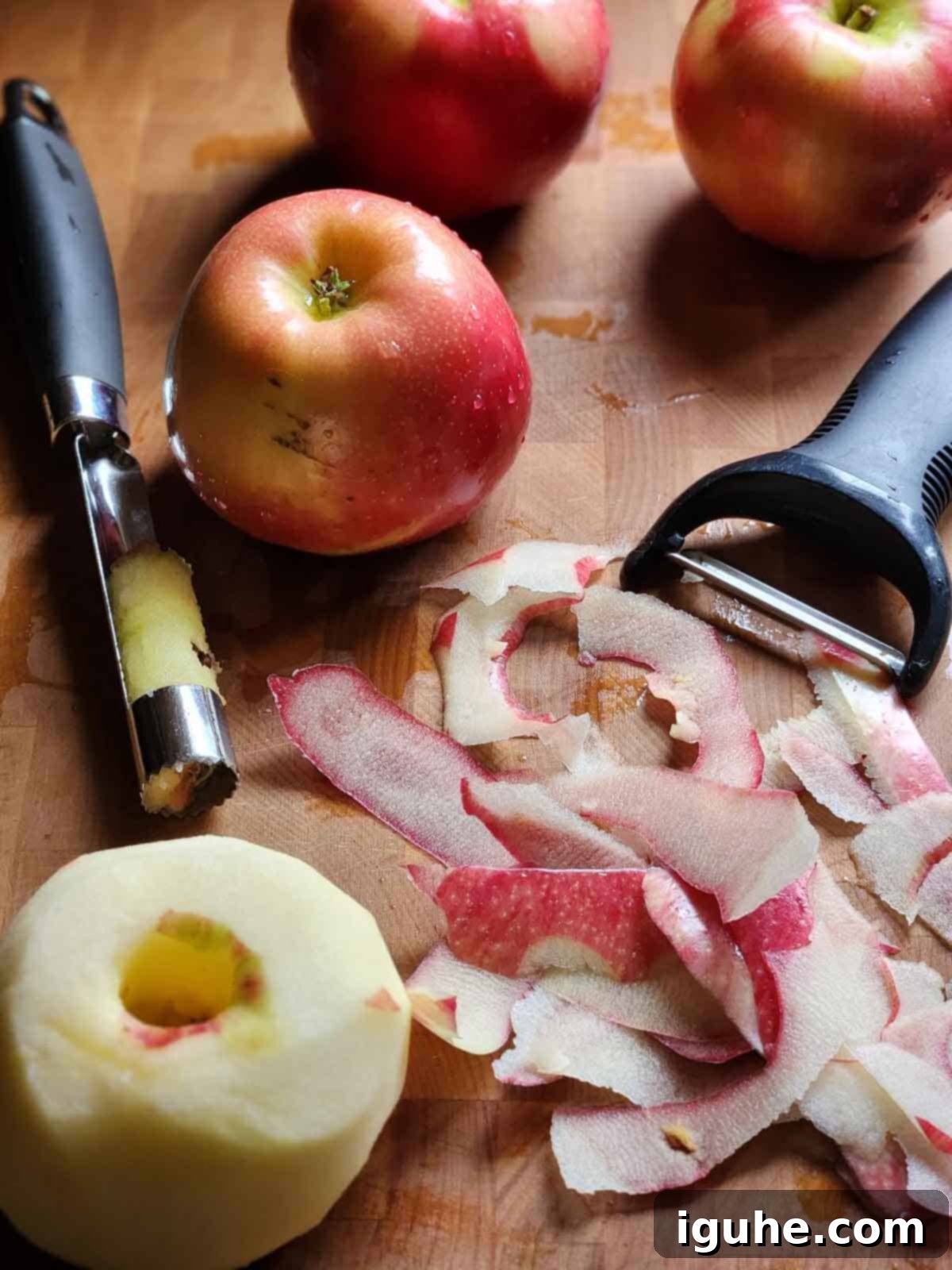
Step 1. Prepare the apples: Start by thoroughly washing your Honeycrisp apples under cold running water. Then, peel them using a vegetable peeler or a paring knife. Finally, carefully core the apples to remove the seeds and fibrous center.
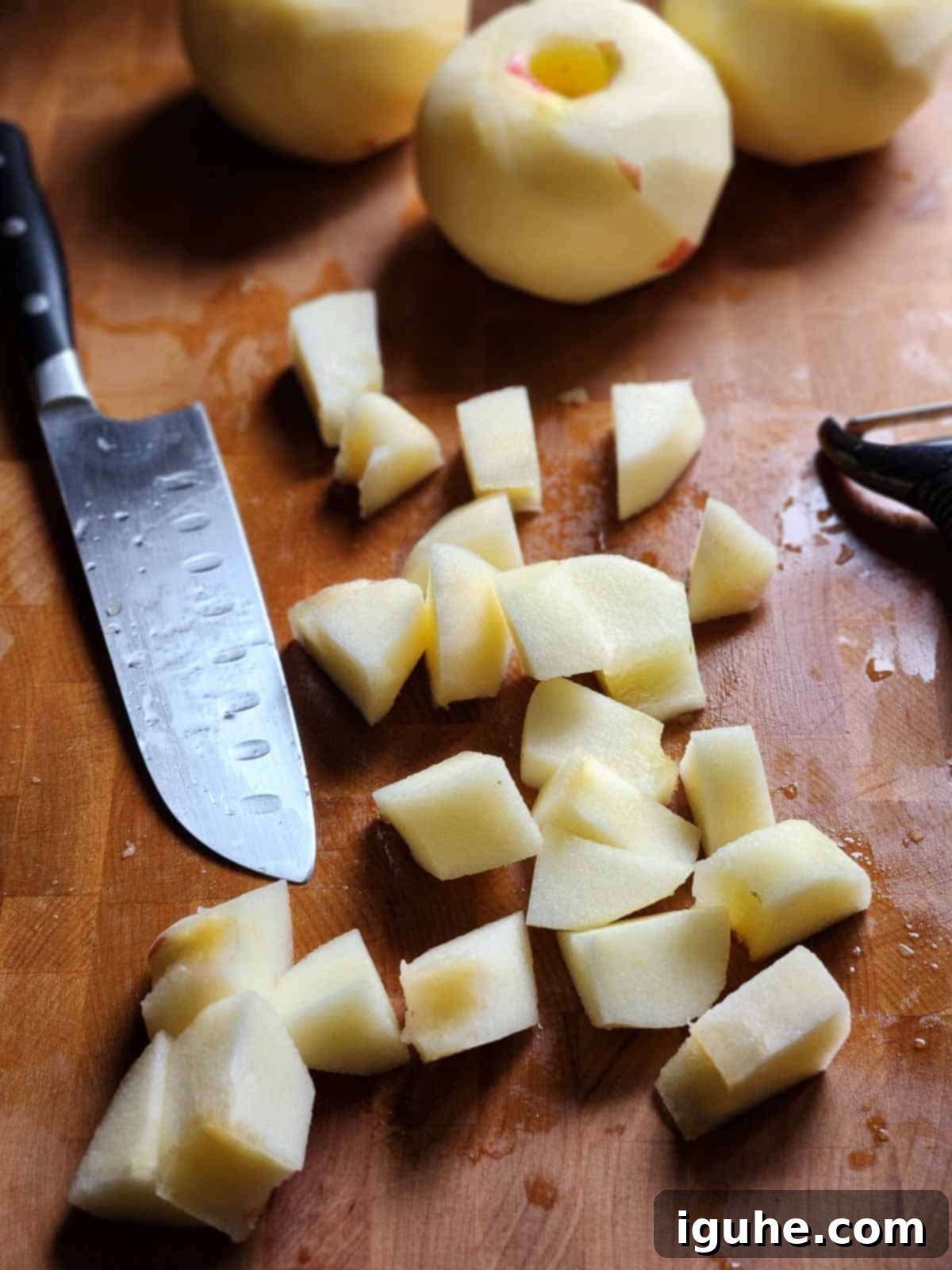
Step 2. Chop the apples: Once peeled and cored, roughly chop the apples into even-sized cubes, about 1-inch thick. Uniform pieces ensure that they cook down at the same rate, resulting in a consistent texture. The exact size isn’t critical, but aim for consistency.
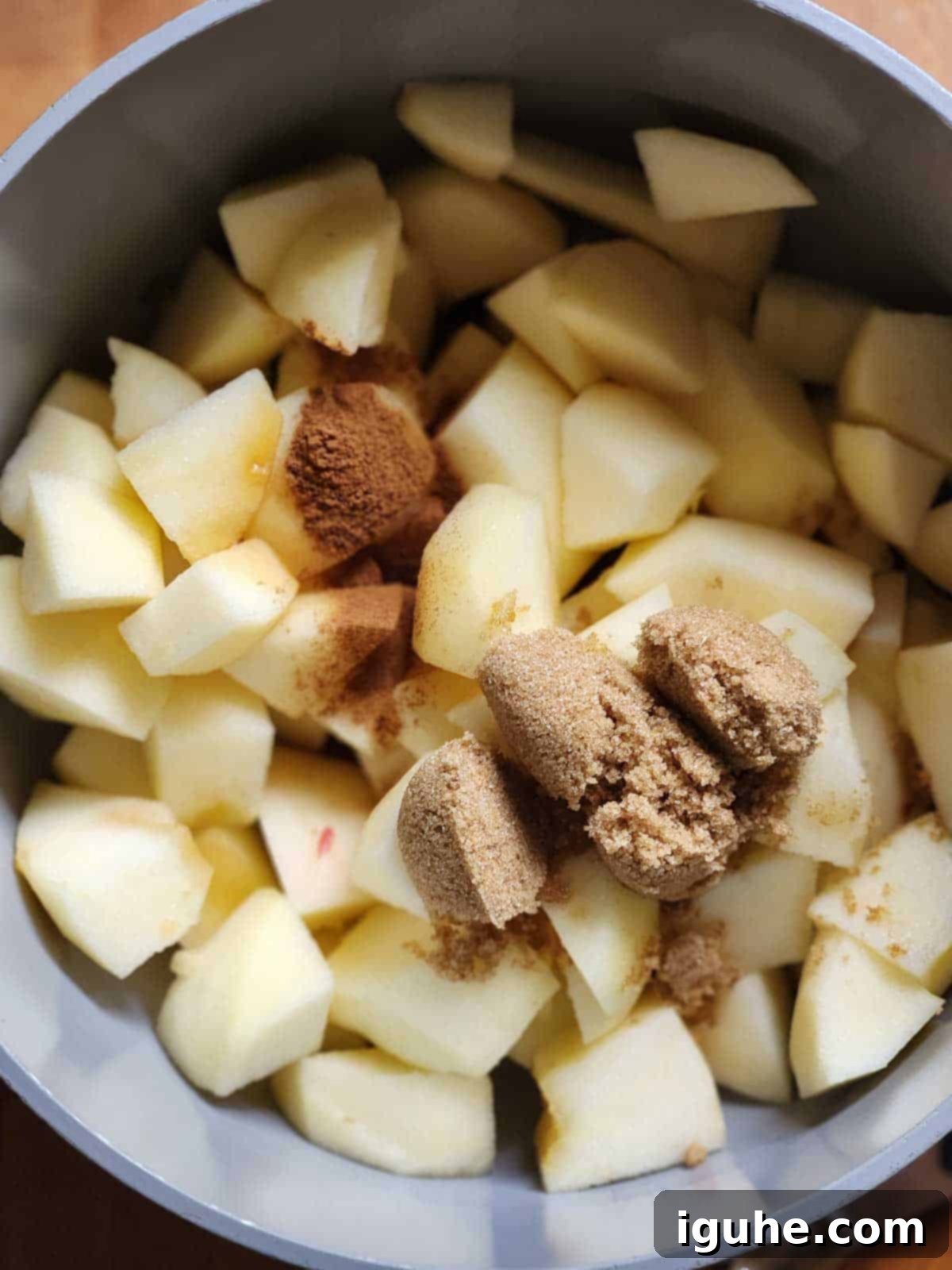
Step 3. Cook the apples: Place all of your prepared ingredients – the chopped apples, water, lemon juice, brown sugar, cinnamon, and the optional boiled cider – into a medium-sized heavy-bottomed pot. Stir everything gently to ensure the apples are well coated with the sugar and spices. Cover the pot with a lid, bring the mixture to a boil over medium-high heat. Once boiling, reduce the heat to medium-low, keep the pot covered, and let it simmer for about 12-15 minutes, or until the apple chunks are wonderfully tender and easily pierced with a fork.
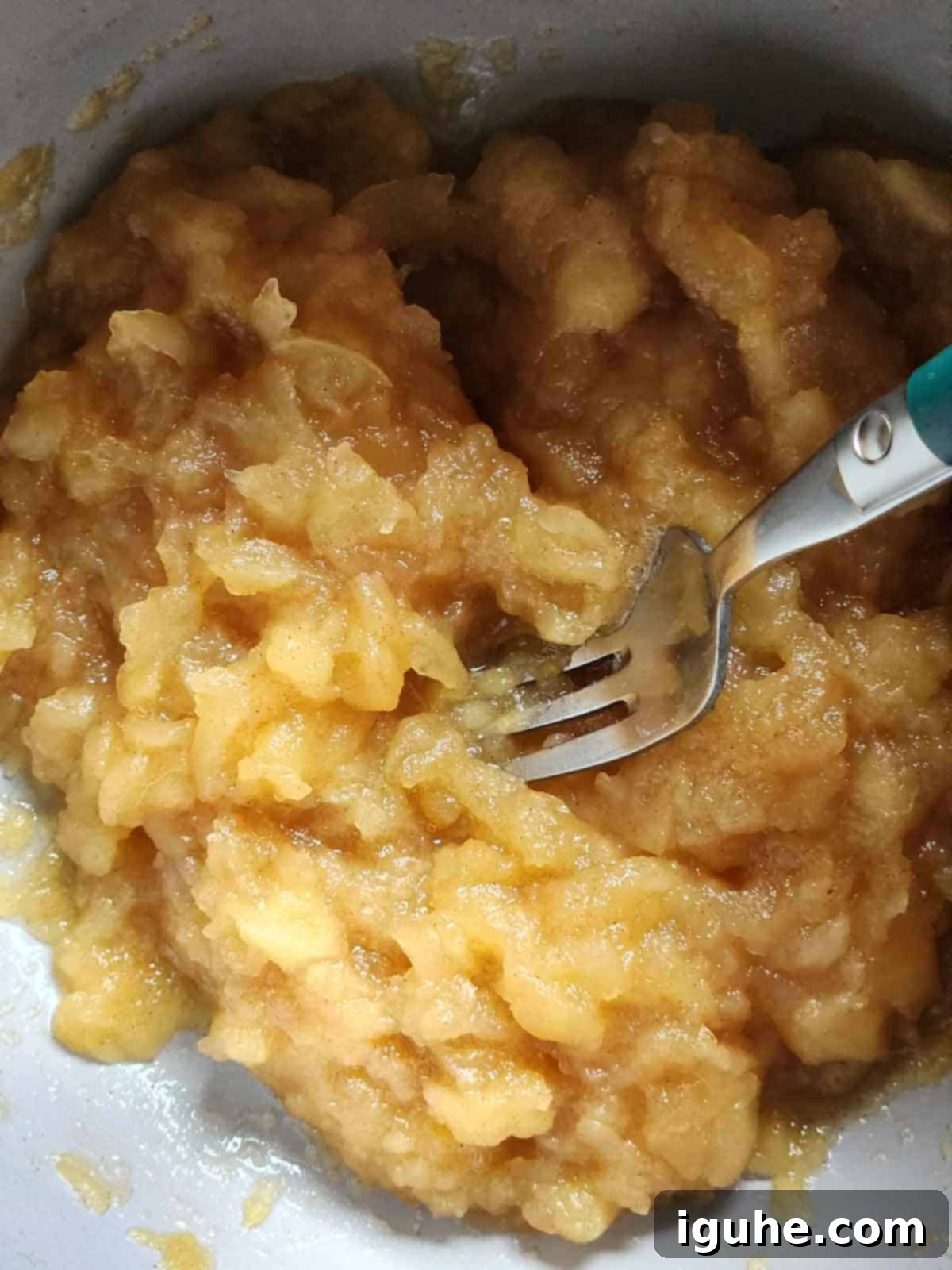
Step 4. Mash to desired consistency: Once the apples are fork-tender, remove the pot from the heat and take off the cover. Using a fork, a potato masher, or even a whisk, begin gently breaking down the cooked apple chunks. Continue mashing until you achieve your preferred consistency – whether you like a chunky, rustic applesauce or a smoother, more uniform texture. For an ultra-smooth puree, you can transfer the applesauce to a food processor or use an immersion blender directly in the pot.
💡Expert Tips for Perfect Homemade Applesauce
Always taste your apples first. Honeycrisps are naturally quite sweet, so if your apples are exceptionally sweet, you might want to reduce the amount of brown sugar called for in the recipe. Similarly, feel free to adjust the cinnamon to your preference; you can add more for a bolder spice or omit it entirely if you prefer a pure apple flavor. Don’t be afraid to customize!
For a chunkier applesauce, cook the apples until just tender and mash them lightly. For a smoother applesauce, cook a bit longer until very soft, then mash thoroughly or blend. If the applesauce seems too thick, you can add a tablespoon or two of hot water to thin it out. If it’s too thin, let it simmer uncovered for a few more minutes to allow some of the liquid to evaporate.
Substitutions and Creative Variations
Don’t have a specific ingredient on hand, or simply want to experiment? Here are some fantastic substitutions and variations to make this applesauce your own!
- Apple Varieties: While Honeycrisps are wonderful, many other apple varieties make excellent applesauce. Good substitutes include McIntosh (very soft, cooks down easily), Fuji (sweet and crisp), Gala (mildly sweet, good texture), Golden Delicious (sweet, softens well), Granny Smith (tart, great for balancing sweetness, might need more sugar), and Jonagold (sweet-tart, firm). A blend of sweet and tart apples can also create a wonderfully complex flavor.
- Acidity Boost (Lemon Juice alternatives): If you don’t have fresh lemon juice, a splash of lime juice can work in a pinch. For a subtle citrus twist, you could even use fresh orange juice, which adds a slightly sweeter, aromatic note. A tiny dash of apple cider vinegar could also provide the necessary tartness and help prevent browning.
- Sweetener Options: Instead of dark brown sugar, light brown sugar will still provide a nice molasses flavor, though it will be slightly less intense. Granulated white sugar can be used for a cleaner, less rich flavor profile. For healthier alternatives, consider maple syrup, honey, or even a sugar substitute, adjusting the quantity to taste. For a no-added-sugar version, rely on the natural sweetness of the Honeycrisp apples and taste as you go.
- Spice It Up: Cinnamon is a classic, but don’t limit yourself! Play around with other warm spices to create unique flavor profiles. A pinch of ground nutmeg, allspice, cloves, or ginger can add wonderful depth. You could also use a pre-mixed apple pie spice blend for convenience. For a more sophisticated touch, a vanilla bean pod or a teaspoon of vanilla extract added at the end of cooking can be delightful.
- Herbaceous Notes: For a surprisingly sophisticated twist, try adding a small sprig of fresh rosemary or thyme during the last few minutes of cooking, then remove before mashing. These herbs pair wonderfully with apples, especially if you plan to use the applesauce in savory dishes.
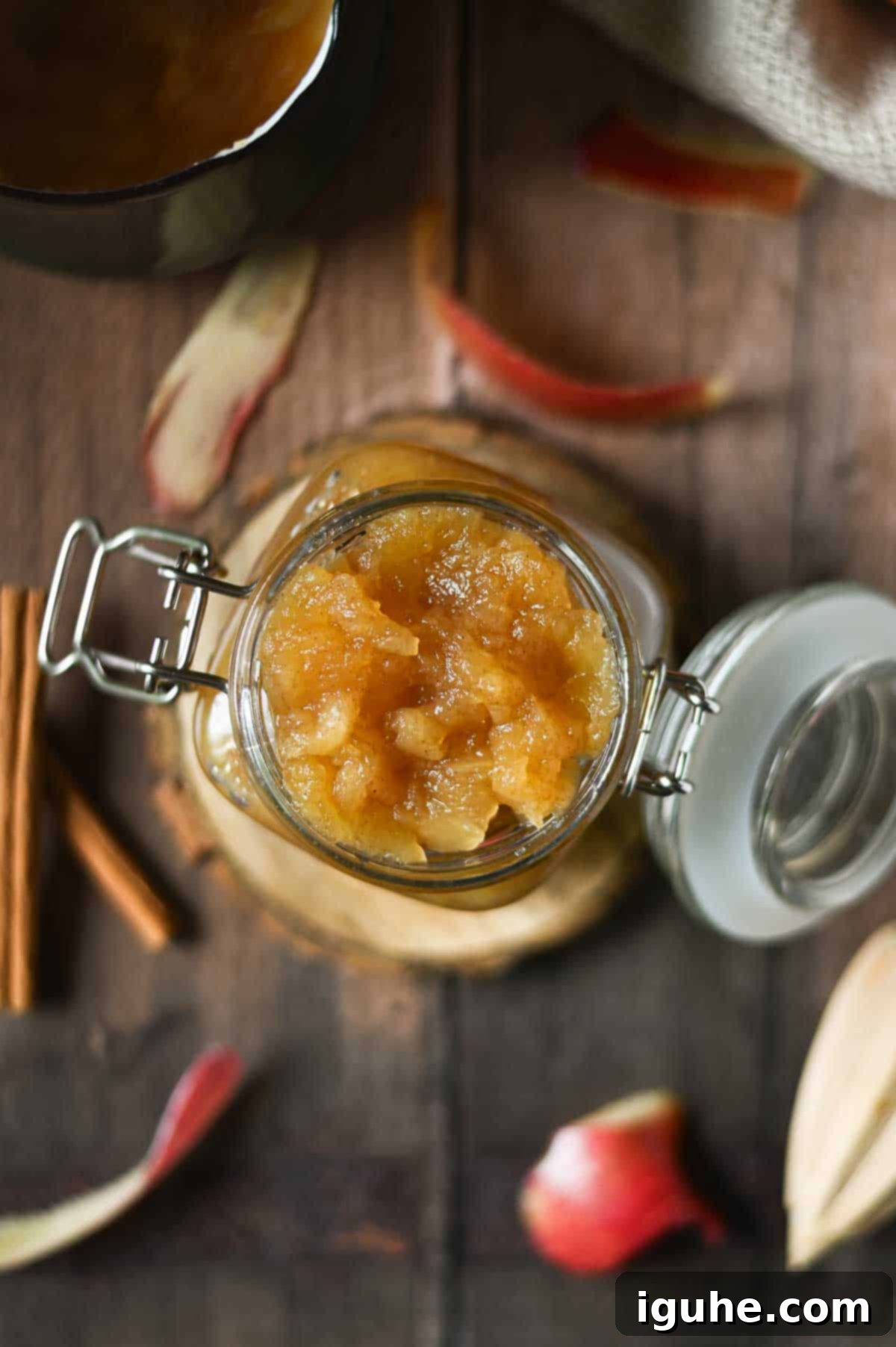
Delicious Ways to Enjoy Your Homemade Honeycrisp Applesauce
Once you’ve made a batch of this incredibly flavorful Honeycrisp applesauce, you’ll find countless ways to enjoy it! Serve it warm for a comforting treat, or chill it for a refreshing snack. Here are just some of the many fantastic applications for your homemade applesauce. What will you try first?
- Breakfast Delights: Move over maple syrup! Applesauce is an exceptional topping for all your favorite breakfast classics. Spoon it generously over fluffy cinnamon sweet cream pancakes, crisp waffles, or golden French toast. It would also go exceptionally well with this light and airy vanilla Dutch baby pancake or tucked inside these delicate ricotta and lemon stuffed crepes for a burst of fruity goodness. Mix it into your morning yogurt or cottage cheese for added flavor and natural sweetness.
- Healthy Snacks & Desserts: Enjoy your applesauce plain, by the spoonful, warm or cold. It’s a fantastic, healthy snack on its own. Layer it into a beautiful fruit parfait with granola and yogurt, or serve it alongside your favorite ice cream, like this no-churn pistachio ice cream for a contrast of flavors. It can also be a simple yet elegant dessert on its own, perhaps with a dollop of whipped cream.
- Oatmeal & Grains: Stir it into your morning bowl of oatmeal or use it as a base for overnight oats for a naturally sweetened and flavored breakfast. You can even elevate your oatmeal by making this easy apple pie brulee oatmeal, incorporating the applesauce for that authentic apple pie taste. It also works well with other grains like quinoa or farro for a sweet side dish.
- Baking & Cooking: Applesauce is a versatile ingredient in baking! It can be used as a healthy substitute for oil or butter, reducing fat content while adding moisture and a touch of sweetness. It’s also excellent as a “moisture maker” in recipes, like these delicious zucchini applesauce muffins, keeping baked goods wonderfully tender. You can also use it as a filling for hand pies, tarts, or a base for quick breads.
- Savory Pairings: Don’t overlook applesauce for savory dishes! It’s a classic and perfect condiment for pairing with rich meats like pork chops, roasted chicken, or a succulent pork roast. The sweetness and acidity cut through the richness of the meat beautifully. Use it as a base for making homemade barbecue sauce, glazes for ham, or other savory fruit-based sauces. Incorporate a spoonful into marinades for chicken or pork to add tenderness and flavor. It can also be a surprising addition to fall-inspired stuffings.
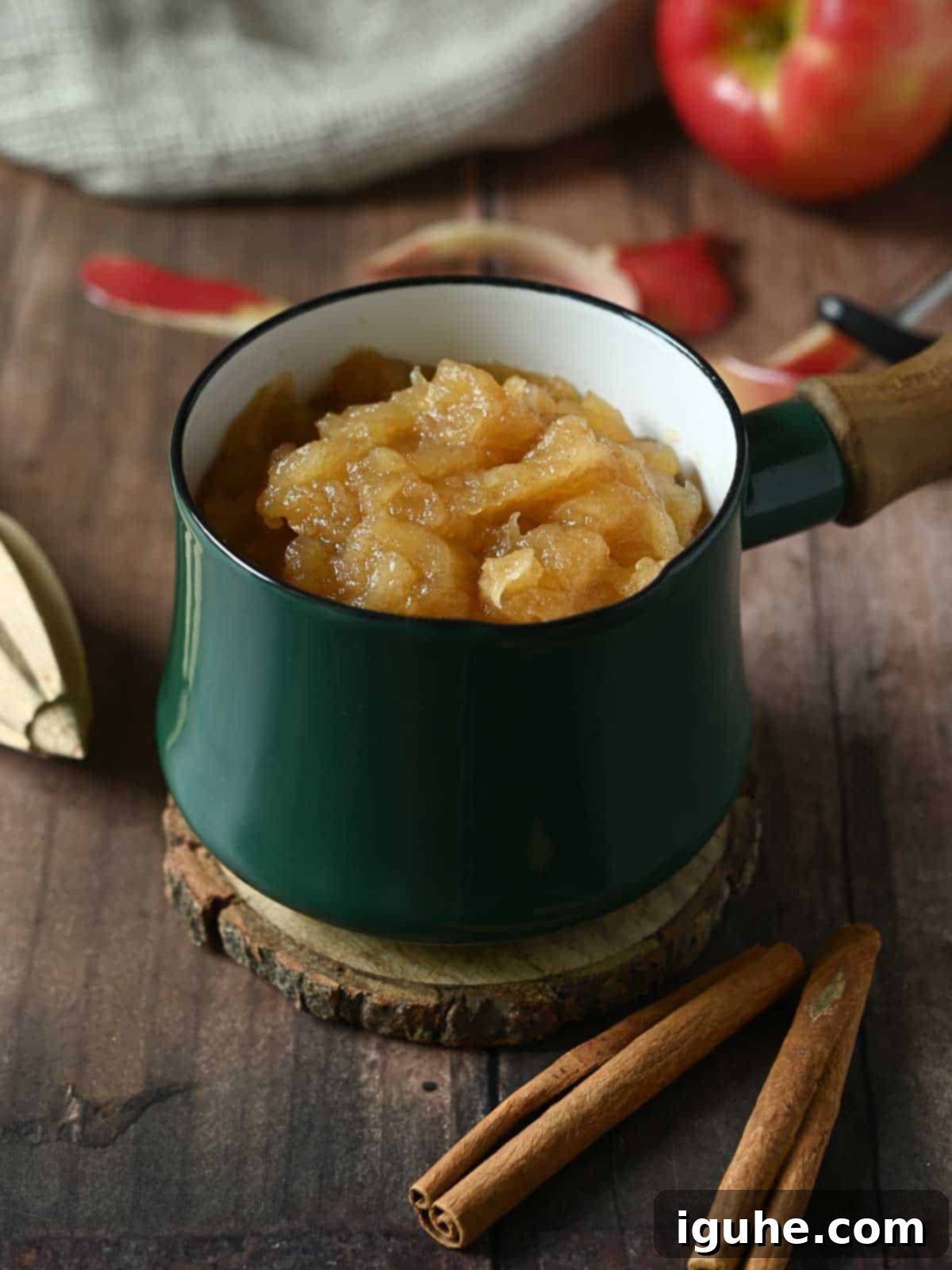
Storing Your Homemade Applesauce
Proper storage ensures you can enjoy your delicious homemade applesauce for as long as possible. Once cooled, transfer the applesauce to an air-tight container and store it in the refrigerator for up to 10 days. For longer storage, applesauce freezes beautifully. Simply transfer it to freezer-safe containers or heavy-duty freezer bags, leaving a little headspace for expansion. It can be frozen for up to 3 months. To thaw, simply move it to the refrigerator overnight or gently reheat it on the stovetop from frozen on low heat.
Frequently Asked Questions About Honeycrisp Applesauce
While canning applesauce is a very common method for long-term preservation, this specific recipe has not been tested for safety with canning procedures (e.g., pH levels and specific cooking times for water bath or pressure canning). Therefore, it is not recommended to can this recipe. If you’re looking to make a larger batch for extended storage, your best bet is to multiply the recipe and freeze the extra portions in freezer-safe jars or containers instead.
Peeling the apples is recommended for the smoothest texture, as apple peels can be tough and might not break down completely, leaving small bits in your applesauce. However, if you prefer a more rustic applesauce and want to retain the extra fiber and nutrients from the peel, you can certainly leave it on. Just be aware that the final texture will be different, and you might want to blend it longer for a more uniform consistency.
To achieve a chunkier applesauce, simply mash the cooked apples lightly with a fork or potato masher, leaving some visible pieces. For a smoother applesauce, continue mashing more vigorously, or use an immersion blender directly in the pot. For an ultra-smooth, puree-like consistency, transfer the cooked apples to a food processor or a standard blender and process until completely smooth. Add a tablespoon of water if it’s too thick to blend.
The beauty of homemade applesauce is its adjustability! If your apples are naturally very tart (like Granny Smiths), you might want to increase the brown sugar by an extra tablespoon or two. If they are exceptionally sweet (like some Honeycrisps), you can reduce the brown sugar, or even omit it entirely for a no-added-sugar version. Always taste the applesauce after cooking and mashing, and adjust the sweetness or tartness with a little more sugar or a squeeze of lemon juice as needed.
Perfect Pairings for Your Homemade Applesauce
Elevate your meals with these delightful recipes that are perfectly complemented by a dollop (or boatload!) of your homemade Honeycrisp applesauce.
- Cinnamon Sweet Cream Pancakes
- No-Churn Pistachio Ice Cream
- Sweet Vanilla Dutch Baby Pancake
- Cranberry Orange Cream Scones
Did you make this recipe? I would love to hear about it! Please leave a ⭐⭐⭐⭐⭐ rating with a comment right below the recipe card. If you snap a photo of your creation, don’t forget to tag me on Instagram @brunchandbatter.
📖 Recipe: Honeycrisp Applesauce with Brown Sugar and Cinnamon
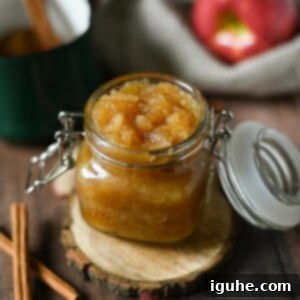
Honeycrisp Applesauce with Brown Sugar and Cinnamon
Pin Recipe
Equipment
-
1 apple corer (optional, but helpful)
-
1 vegetable peeler (optional, but recommended for smooth applesauce)
-
1 medium-sized heavy-bottomed pot
-
1 potato masher, fork, or immersion blender (for mashing)
Ingredients
- 4 medium (about 1¼ pounds) Honeycrisp apples
- ¼ (2 ounces) cup water
- 2 teaspoon fresh lemon juice
- 2 tablespoon dark brown sugar
- ¼ teaspoon ground cinnamon
- ½ tablespoon boiled cider, optional
Instructions
-
Prepare the apples: Begin by washing, peeling, and coring your Honeycrisp apples. Then, cut them into rough, even-sized cubes (about 1-inch pieces).4 medium (about 1¼ pounds) Honeycrisp apples
-
Cook the apples: In a medium-sized heavy-bottomed pot, combine the prepared apples with the water, fresh lemon juice, dark brown sugar, ground cinnamon, and the optional boiled cider. Stir everything together to ensure the apples are well coated. Cover the pot with a lid and bring the mixture to a boil over medium-high heat. Once it starts boiling, reduce the heat to medium-low, keep the pot covered, and continue to simmer for 12-15 minutes, or until the apple pieces are very tender and easily crushed with a fork.¼ (2 ounces) cup water, 2 teaspoon fresh lemon juice, 2 tablespoon dark brown sugar, ¼ teaspoon ground cinnamon, ½ tablespoon boiled cider, optional
-
Mash to desired consistency: Remove the pot from the heat and take off the cover. Using a fork, potato masher, or immersion blender, break down the softened apples until you reach your desired consistency – whether chunky or smooth. For a silky-smooth puree, you can transfer the applesauce to a food processor or standard blender and process until smooth. Taste and adjust sweetness or spice if necessary. Enjoy your homemade applesauce warm, or refrigerate it until ready to use.
Notes
Storage: Store any leftover applesauce in an air-tight container in the refrigerator for up to 10 days. For longer storage, it can be frozen in freezer-safe containers for up to 3 months. This recipe has not been tested for canning safety and is therefore not recommended for home canning.
Nutrition*
*Nutrition information is provided as a courtesy and is an estimate only. Nutrition information can vary depending on many factors, such as products used, measurements and substitutions, therefore it is recommended that you obtain nutritional calculations based on your own finished recipe.
